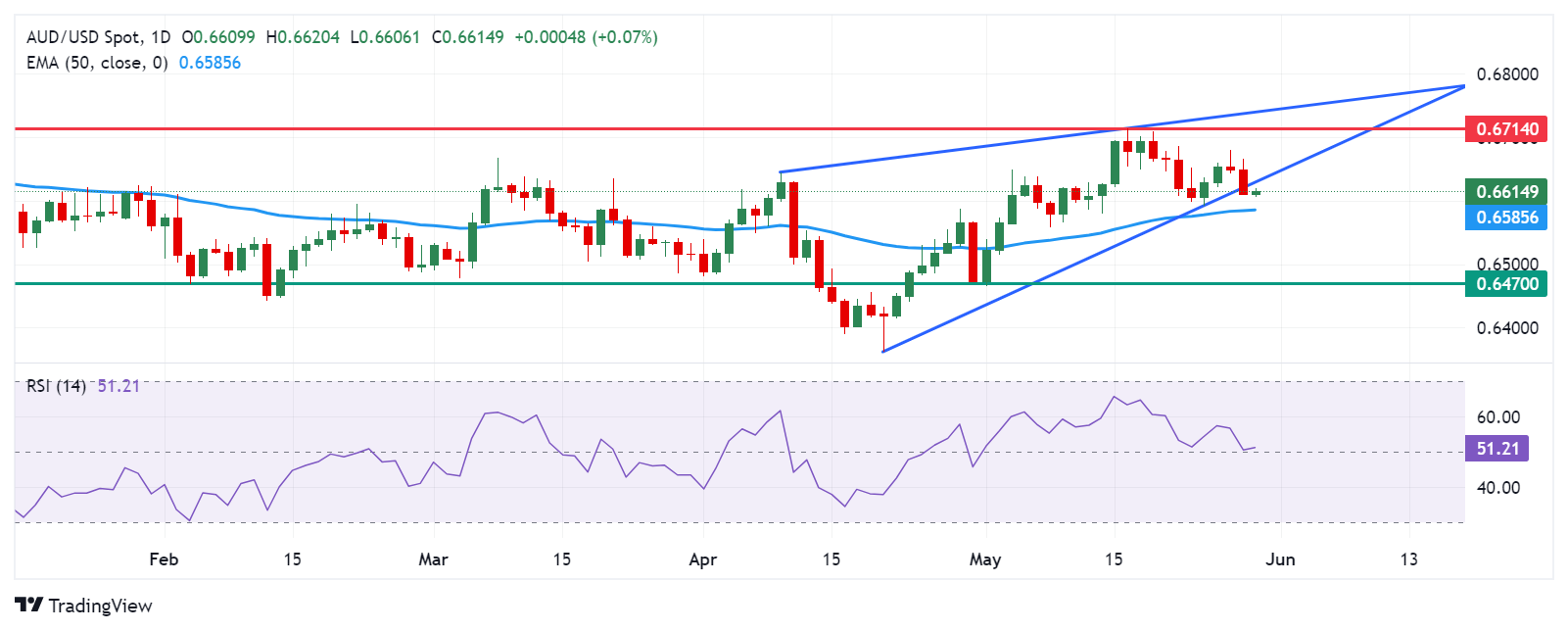Australian Dollar rebounds as 10-year Government Bond Yield reaches four week highs
- The Australian Dollar gains ground as the Aussie 10-year Government Bond Yield reaches a four-week high of 4.52%.
- Australia’s Private Capital Expenditure rose 1.0% in Q1, surpassing the expected 0.5% rise.
- The US Dollar’s strength is reinforced as Treasury yields appreciate on risk aversion.
The Australian Dollar (AUD) rebounded on Thursday, possibly driven by the Australian 10-year Government Bond Yield increase to a four-week high of 4.52%. This shift reflects investor sentiment that the Reserve Bank of Australia (RBA) will maintain higher interest rates for longer. Additionally, the AUD might gain ground as one of its largest trading partners, China, has lifted bans on beef shipments from five major Australian meat producers.
Australia's Monthly Consumer Price Index, released on Wednesday, showed robust figures that could prompt the RBA to consider another rate hike. The minutes from the RBA's May policy meeting suggested that the central bank had contemplated a potential interest rate increase.
The US Dollar Index (DXY), which measures the USD against six major currencies, trades higher around 105.10, with 2-year and 10-year US Treasury yields at 4.98% and 4.61%, respectively, at the time of reporting. Risk aversion sentiment supports the US Dollar (USD), limiting the advances of the AUD/USD pair.
On Wednesday, the Fed Beige Book report covering the period from April to mid-May showed that national economic activity experienced slight growth, with mixed conditions across industries and districts. The report also indicated that employment rose slightly, wage growth was moderate, and prices increased modestly as consumers resisted further price hikes.
Daily Digest Market Movers: Australian Dollar appreciates as RBA’s Hunter concerns about inflation
- RBA Assistant Governor (Economic) Sarah Hunter stated that they concur with the Treasury's inflation forecast. The CPI data indicates strength in certain price sectors. The RBA Board is clearly concerned about inflation remaining above the target range, suggesting persistent inflationary pressure. Wages growth appears to be near its peak.
- According to the CME FedWatch Tool, the likelihood of the Federal Reserve implementing a 25 basis-point rate cut in September decreased to 41.7%, down from 49.4% a week earlier.
- Australia’s Monthly Consumer Price Index rose 3.6% year-over-year in April, surpassing the expected reading of 3.4% and the previous reading of 3.5%.
- On Tuesday, Neel Kashkari, President of the Federal Reserve Bank of Minneapolis, suggested that a rate hike might still be possible. Kashkari stated, “I don’t think anybody has totally taken rate increases off the table,” and expressed uncertainty about the disinflationary process, predicting only two rate cuts, per MSN.
- US Housing Price Index (MoM) for March was underperforming, with March's number coming in at 0.1% against 1.2% for February, where 0.5% was expected.
- Australia's Retail Sales (MoM) rose by 0.1% in April, swinging from the previous 0.4% decline. This growth fell short of market expectations of 0.2%.
Technical Analysis: Australian Dollar could test the key level of 0.6600
The Australian Dollar trades around 0.6610 on Thursday. An analysis of the daily chart suggests the weakening of a bullish bias for the AUD/USD pair, as it has broken below the lower boundary of a rising wedge. The 14-day Relative Strength Index (RSI) is positioned on the 51 level, further decline may confirm the momentum shift.
The AUD/USD pair could potentially move back into the rising wedge to target the four-month high of 0.6714, followed by the upper limit of the rising wedge around 0.6740.
On the downside, the immediate support appears at the psychological level of 0.6600, followed by the 50-day Exponential Moving Average (EMA) at 0.6584. A further decline could exert downward pressure on the AUD/USD pair, potentially driving it toward the throwback support region at 0.6470.
AUD/USD: Daily Chart

Australian Dollar price today
The table below shows the percentage change of the Australian Dollar (AUD) against listed major currencies today. The Australian Dollar was the strongest against the Swiss Franc.
| USD | EUR | GBP | CAD | AUD | JPY | NZD | CHF | |
| USD | 0.03% | -0.01% | -0.01% | 0.01% | -0.12% | 0.08% | 0.10% | |
| EUR | -0.03% | -0.04% | -0.02% | -0.03% | -0.14% | 0.05% | 0.06% | |
| GBP | 0.02% | 0.04% | 0.03% | 0.00% | -0.10% | 0.10% | 0.10% | |
| CAD | -0.01% | 0.02% | -0.02% | -0.01% | -0.12% | 0.07% | 0.08% | |
| AUD | 0.00% | 0.03% | -0.01% | 0.01% | -0.10% | 0.08% | 0.09% | |
| JPY | 0.10% | 0.14% | 0.07% | 0.09% | 0.12% | 0.18% | 0.19% | |
| NZD | -0.08% | -0.04% | -0.09% | -0.08% | -0.09% | -0.18% | 0.01% | |
| CHF | -0.08% | -0.06% | -0.10% | -0.08% | -0.08% | -0.20% | -0.01% |
The heat map shows percentage changes of major currencies against each other. The base currency is picked from the left column, while the quote currency is picked from the top row. For example, if you pick the Euro from the left column and move along the horizontal line to the Japanese Yen, the percentage change displayed in the box will represent EUR (base)/JPY (quote).
Australian Dollar FAQs
One of the most significant factors for the Australian Dollar (AUD) is the level of interest rates set by the Reserve Bank of Australia (RBA). Because Australia is a resource-rich country another key driver is the price of its biggest export, Iron Ore. The health of the Chinese economy, its largest trading partner, is a factor, as well as inflation in Australia, its growth rate and Trade Balance. Market sentiment – whether investors are taking on more risky assets (risk-on) or seeking safe-havens (risk-off) – is also a factor, with risk-on positive for AUD.
The Reserve Bank of Australia (RBA) influences the Australian Dollar (AUD) by setting the level of interest rates that Australian banks can lend to each other. This influences the level of interest rates in the economy as a whole. The main goal of the RBA is to maintain a stable inflation rate of 2-3% by adjusting interest rates up or down. Relatively high interest rates compared to other major central banks support the AUD, and the opposite for relatively low. The RBA can also use quantitative easing and tightening to influence credit conditions, with the former AUD-negative and the latter AUD-positive.
China is Australia’s largest trading partner so the health of the Chinese economy is a major influence on the value of the Australian Dollar (AUD). When the Chinese economy is doing well it purchases more raw materials, goods and services from Australia, lifting demand for the AUD, and pushing up its value. The opposite is the case when the Chinese economy is not growing as fast as expected. Positive or negative surprises in Chinese growth data, therefore, often have a direct impact on the Australian Dollar and its pairs.
Iron Ore is Australia’s largest export, accounting for $118 billion a year according to data from 2021, with China as its primary destination. The price of Iron Ore, therefore, can be a driver of the Australian Dollar. Generally, if the price of Iron Ore rises, AUD also goes up, as aggregate demand for the currency increases. The opposite is the case if the price of Iron Ore falls. Higher Iron Ore prices also tend to result in a greater likelihood of a positive Trade Balance for Australia, which is also positive of the AUD.
The Trade Balance, which is the difference between what a country earns from its exports versus what it pays for its imports, is another factor that can influence the value of the Australian Dollar. If Australia produces highly sought after exports, then its currency will gain in value purely from the surplus demand created from foreign buyers seeking to purchase its exports versus what it spends to purchase imports. Therefore, a positive net Trade Balance strengthens the AUD, with the opposite effect if the Trade Balance is negative.




